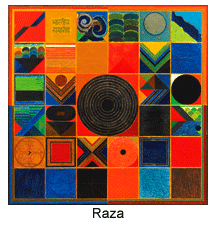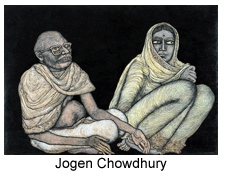- Prelude
- Hard Talk
- New Media
- Rolex : An Overview
- The age of Revivals: Neoclassical Furniture
- Democratization of the Medium No-Budget film: the Indian Context (!)
- Old Sound New Sound
- Decan Odyssey
- North East Opsis
- Russian cool breeze in hot Paris
- Around Kolkata
- Musings from Chennai
- In and around Santiniketan
- In between – from Vadodra
- A Tryst with Art in Madhya Pradesh
- Through the Looking Glass
- The Foreign Connection
- Market Insight
- Market Report
- Artist Index and Statistics
- Auction Reports
- The month that was
- Delhi Dias
- Art Bengaluru
- Mumbai Art Sighting
- Creative Impulse
- Subodh Gupta
- Pooja Iranna
- Preview
- In the News
ART news & views
Market Insight
Volume: 2 Issue No: 9 Month: 10 Year: 2010
September was again a month for Indian and South East Asian Art, with the duopoly of Sotheby's and Christie's holding their Asian Week sales, and SaffronArt holding its Autumn Sales.  The results were encouraging, with Syed Haider Raza again grossing at the highest, followed by M F Husain. Even younger Indian artists like T V Santosh, Riyaz Komu and Anju Dodiya impressed on the International arena. But a closer look at the movement of artworks by senior Indian artists leaves one with mixed feelings.
The results were encouraging, with Syed Haider Raza again grossing at the highest, followed by M F Husain. Even younger Indian artists like T V Santosh, Riyaz Komu and Anju Dodiya impressed on the International arena. But a closer look at the movement of artworks by senior Indian artists leaves one with mixed feelings.
How?
First to Raza's movements. His Acrylic on Canvas 'Bhartiya Samaroh' went for $905,000, at SaffronArt's Autumn sale. This was $100,000 more than its higher estimate. That's huge by any standards, especially when achieved on an online auction. In another part of the world, a couple of days later, Raza's 'La Terre', put under the hammer at Christie's Indian and South Asian Sale at Rockefeller Centre went for an even higher sum-- $1,930,000. However, the irony of Raza also lies here. Christie's had estimated his 'La Terre' in the range of $2,000,000 and $2,500,000. The canvas going for $1,930,000 means that on this occasion, at the international floor, Raza fell $70,000 short of even his lower estimate. At an auction level of the nature of Christie's, that may not be much. But again, one should also keep in mind that only a couple of months back, at the June auction organized by the same auction house, it was the same artist's 'Saurashtra' that set a new record for Indian Contemporary Art in the International market, going for $3,486,965.  A record that, experts felt, will need a long time to be toppled and as it turns out now, even by the creator himself! After 'Saurashtra's success, it was only natural for an auction house like Christie's, to go a bit overboard with the estimate of Raza's work, crossing the border of its well-touted, post-2009, post-recession 'rational estimate' strategy. Of course size and oeuvre mattered. 'La Terre' stands no comparison to 'Saurashtra' on these grounds. And Christie's made it quite clear in its cataloguing routine. So why price it in such a way? According to insiders, in the current scenario, when the market is bullish, and first half sales have brought many a rosy smile to the powers-that-be, it was only natural that all that caution be thrown to the wind. And what better place and time to try mount the riding bull but at the beginning of the second half of the season, especially when the auction concerned is dedicated mostly to artists of Indian origin? After all, responses here will have no effect on the secondary market of artists of European and American origins, past-masters in that genre, but the bull's agility will be duly tasted. Be that as it may, Sotheby's refused to tow the same line. At its sale of Contemporary Indian and South East Asian Art, it was M F Husain who led the lots. His 'Cinq Sens', for which Sotheby's PR blitzkrieg went all-out the previous month, originally from the private collection of Husain's friend, the Italian film-director, Roberto Rossellini, was the highest grosser in this category, going for $782,500, a clean $82,500 over its higher estimate.
A record that, experts felt, will need a long time to be toppled and as it turns out now, even by the creator himself! After 'Saurashtra's success, it was only natural for an auction house like Christie's, to go a bit overboard with the estimate of Raza's work, crossing the border of its well-touted, post-2009, post-recession 'rational estimate' strategy. Of course size and oeuvre mattered. 'La Terre' stands no comparison to 'Saurashtra' on these grounds. And Christie's made it quite clear in its cataloguing routine. So why price it in such a way? According to insiders, in the current scenario, when the market is bullish, and first half sales have brought many a rosy smile to the powers-that-be, it was only natural that all that caution be thrown to the wind. And what better place and time to try mount the riding bull but at the beginning of the second half of the season, especially when the auction concerned is dedicated mostly to artists of Indian origin? After all, responses here will have no effect on the secondary market of artists of European and American origins, past-masters in that genre, but the bull's agility will be duly tasted. Be that as it may, Sotheby's refused to tow the same line. At its sale of Contemporary Indian and South East Asian Art, it was M F Husain who led the lots. His 'Cinq Sens', for which Sotheby's PR blitzkrieg went all-out the previous month, originally from the private collection of Husain's friend, the Italian film-director, Roberto Rossellini, was the highest grosser in this category, going for $782,500, a clean $82,500 over its higher estimate.  Again nothing much happened at an international level but then, one takes heart in noting that this happened in the case of an Indian artist, and even there, he wasn't toppling any kind of personal secondary market record.
Again nothing much happened at an international level but then, one takes heart in noting that this happened in the case of an Indian artist, and even there, he wasn't toppling any kind of personal secondary market record.
Sotheby's grossed $7,547,250 from this sale of 110 lots, with the top-ten featuring Bhupen Khakhar, Arpita Singh, Akbar Padamsee, Subodh Gupta and Tyeb Mehta, other than Husain. But what is important to note here is how, at least four out of the top-ten, were scooped up by private Indian collectors, including the highest grossed 'Cinq Sens'. This trend can have various interpretations. Sadly, none of it goes in favour of the penetration of Indian Contemporary Art in the International market. Not as of now at least. If a top grossing lot at an international auction is picked up by a private Indian collector, it surely goes in favour of the auction house which is eyeing the secondary Indian art market, with its own corpus of buyers.
Why so? Because with China emerging strong and fast, that too with its own auction houses on the international arena, India is the only other South Eastern economy that can be exploited in this field by institutions with a global presence, since the indigenous auction market is nascent to say the least. Also, if a top grossing lot at an international auction is picked up by a private Indian collector, it further goes on to show that there is a strong NRI buyer market, that is well-financed and sentimental something that was proved earlier this year when two of Rabindranath Tagore's works from the Elmharst Collection were snatched up by NRI Bengalis.  All that may be very good on the surface, but one also needs to wait and see if this emerging set of Indian investors is savvy, objective and shrewd enough to roll their possessions on a global market with the same energy with which their American or European counterparts have been doing all these years. Till that happens, Indian Contemporary Artists will remain sitting in the International Market dug out. Nevertheless, as things stand now, the global duopoly of Sotheby's and Christie's stand to gain both ways by this trend. Sell primary possessions and explore an alternative secondary market as an answer to Chinese auction houses like Poly and China Guardian, who by the way keep themselves restricted to works by artists of Chinese origin and are set upon penetrating the international market as a counterforce to art-mart's long-time global duopoly. And here lies the important question. Do Indians take heart from the example of China and develop hegemony strong enough to project Indian Contemporary Artists on the global art-mart on their own terms? Or allow the global duopoly have its way? It may not be out of context here to mention that Kolkata's very own Jogen Chowdhury did exceptionally well at SaffronArt's autumn auction. His 'Couple I' an Ink and Pastel on Paper creation was estimated in the range of $133,335 - 155,560. The winning bid was $354,583 more than double the highest estimate. This fact, coupled with the performance of Raza's 'Bhartiya Samaroh' at the same auction proves just one point. The backroom artists that is-- seems prepared to take the secondary market head-on at a global level. If Indian art-investors will have the savvy to develop the front-room in fracture and take this forward to global art-mart's main playing fields is a question that still remains to be answered.
All that may be very good on the surface, but one also needs to wait and see if this emerging set of Indian investors is savvy, objective and shrewd enough to roll their possessions on a global market with the same energy with which their American or European counterparts have been doing all these years. Till that happens, Indian Contemporary Artists will remain sitting in the International Market dug out. Nevertheless, as things stand now, the global duopoly of Sotheby's and Christie's stand to gain both ways by this trend. Sell primary possessions and explore an alternative secondary market as an answer to Chinese auction houses like Poly and China Guardian, who by the way keep themselves restricted to works by artists of Chinese origin and are set upon penetrating the international market as a counterforce to art-mart's long-time global duopoly. And here lies the important question. Do Indians take heart from the example of China and develop hegemony strong enough to project Indian Contemporary Artists on the global art-mart on their own terms? Or allow the global duopoly have its way? It may not be out of context here to mention that Kolkata's very own Jogen Chowdhury did exceptionally well at SaffronArt's autumn auction. His 'Couple I' an Ink and Pastel on Paper creation was estimated in the range of $133,335 - 155,560. The winning bid was $354,583 more than double the highest estimate. This fact, coupled with the performance of Raza's 'Bhartiya Samaroh' at the same auction proves just one point. The backroom artists that is-- seems prepared to take the secondary market head-on at a global level. If Indian art-investors will have the savvy to develop the front-room in fracture and take this forward to global art-mart's main playing fields is a question that still remains to be answered.